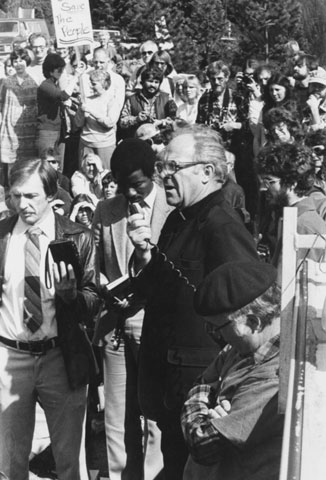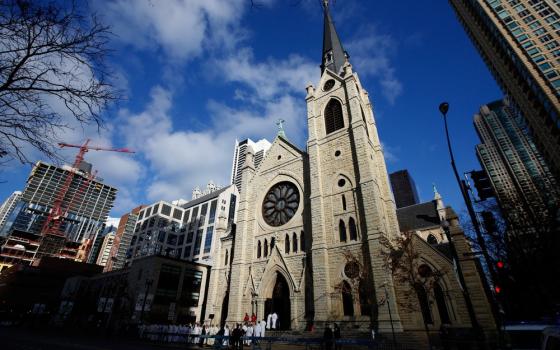
Archbishop* Raymond Hunthausen participates in a Way of the Cross in April 1982. (NCR photo/Gordon Oliver)
 A STILL AND QUIET CONSCIENCE: THE ARCHBISHOP WHO CHALLENGED A POPE, A PRESIDENT, AND A CHURCH
A STILL AND QUIET CONSCIENCE: THE ARCHBISHOP WHO CHALLENGED A POPE, A PRESIDENT, AND A CHURCH
By John A. McCoy
Published by Orbis, $26
It is one thing to suffer for the church, but quite another to suffer from the church. We understand that any Christian trying to bear witness to the Gospel will encounter pushback from the consumer-oriented, self-satisfied corners of our society. One would be naive to think otherwise. But to suffer public censure and humiliation from the church itself for bearing witness to the Gospel is particularly hurtful.
John McCoy's biography of Archbishop Raymond "Dutch" Hunthausen paints the painful story of a bishop's conscience and Rome's determination to hold fast to institutional control.
Whether or not Hunthausen's withholding of half his federal income tax as protest against nuclear weapons marked "a pivotal point in the history of the U.S. Catholic Church" as McCoy contends, it was unprecedented as a prophetic voice from an American Catholic bishop -- and raised alarm bells in the halls of the Roman Curia.
Hunthausen, transformed by the profound breakthroughs of the Second Vatican Council, made the pastoral care of his priests, religious and laity a priority. In doing so, he would earn the disdain often accorded to a prophet and raised the suspicions of Rome. In the eyes of the entrenched church leaders committed to at least containing, if not reversing, the reforms of the council, a bishop whose pastoral judgment didn't always square with canon law and the church's official teachings was indeed dangerous.
Reading McCoy's account of Hunthausen's flourishing, from his boyhood years in Anaconda, Mont., to his post as archbishop of Seattle, I saw an unpretentious, gifted man move from the disciplined, traditionalist Catholicism of his youth and seminary training to become a man of the Gospel who, by the grace of God, caught the spirit of the freedom of the children of God. The Gospel, understood afresh by the lights of Vatican II, had set him free.
Hunthausen had finally got it. If the church is hierarchic, it is also communal. If the church is about doctrine and right living, it is also about being caught up in the mystery of the divine presence in all believers. If ordained ministry is essential to the mission of the church, the ministry of the baptized is also central to that mission. If the church is the comforter of the oppressed and champion of the poor, it is also a prophetic voice to the world's powers for human rights, economic justice and nuclear disarmament.
Hunthausen's freedom was a freedom to be faithful -- to the Gospel, to the teachings of the church, but especially to his conscience.
The seeds of Hunthausen's prophetic witness -- which led to his long, dark night and public humiliation -- were sown soon after his arrival in Seattle as archbishop, and nourished, McCoy tells us, by the writings of Jesuit Fr. Richard McSorley and conversations with the peace activist Jim Douglass.
Study, prayer, and long talks into the night with Douglass and others crystalized into the courage and conviction Hunthausen drew on to speak out in 1982 against the U.S. buildup of unprecedented nuclear submarine power and the threat of a nuclear Armageddon.
McCoy is at his best, I believe, in giving his readers a step-by-step account of how the Roman system goes about reining in one of its rogue bishops.
Hunthausen had real difficulty finding out what charges had been leveled against him. Eventually, he's informed of concerns about doctrinal purity -- his "unwillingness or inability to instruct and enforce Catholic teaching" and illicit liturgical practices such as leavened altar breads, among others.
Hunthausen responded that the accusations were misrepresentations, taken out of context, or simply inconsequential.
McCoy reports with a fresh eye the Vatican-ordered "visitation" in the 1980s -- really a formal investigation by Archbishop James Hickey -- and the assignment of Donald Wuerl as an auxiliary bishop. Wuerl was vested with powers superseding the archbishop's in areas of governance that the Vatican saw as lax or unfaithful to church teaching.
The tension mounts as Pope John Paul II and Cardinal Joseph Ratzinger's "reform of the reform" ecclesial vision and the temperaments of the Vatican emissaries clash with Hunthausen's pastoral vision and leadership style. We see here, behind the surface cordiality of the Vatican delegates, the bureaucratic stalling, indirection and secrecy that proved so frustrating and painful to Hunthausen.
In "The Explanation," the chapter perhaps most open to criticism, McCoy takes on the job of probing the "why" of the Vatican's actions against Hunthausen.
"John Paul and Ratzinger," McCoy writes, "decided to send the U.S. bishops a very strong message. The message had two parts: (1) there will be no peace pastoral that upsets our relationship with the Reagan administration; and (2) we -- not you -- will decide and enforce Catholic teaching and practice in the American church."
Yet the Vatican nuncio at the time, Archbishop (later Cardinal) Pio Laghi insisted the Vatican had not acted against Hunthausen because of his peace activities but because of its concern for doctrinal and pastoral integrity. Profoundly disturbed by what they saw to be the lax state of Catholicism in the U.S., the pope and the cardinal, McCoy writes, decided to make an example of one U.S. bishop -- Raymond Hunthausen.
The formula was simple: "Investigate, embarrass, and punish one bishop, and the others will mend their ways."
I tend to agree with McCoy's analysis, but taking the measure of the Vatican's motives for moving on Hunthausen will leave any writer vulnerable to critique. McCoy's treatment of the "why" behind the archbishop's ordeal remains believable if not compelling.
A Still and Quiet Conscience is a fitting tribute to a brave, faithful man of the church who suffered the familiar lot of the prophets. It is also a snapshot of a polarized church, clashing ecclesiologies, clerical maneuvering, and hierarchical power at its height. At the same time, it's a story of a church that can heal your soul and break your heart.
Recently, I spoke with a priest who had served under Hunthausen and I asked how Dutch was doing. He said the archbishop, now well into his 90s, has visitors and receives phone calls but spends a great deal of time, in his own words, "just sitting and letting God love me."
[Fr. Donald Cozzens is writer in residence at John Carroll University. His latest books are Notes from the Underground: The Spiritual Journal of a Secular Priest and Master of Ceremonies, a novel.]
*Correction: In an earlier version of this book review, the photo caption included the wrong title for Raymond Hunthausen. By 1982, Hunthausen was already archbishop of Seattle.



